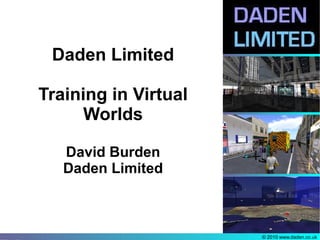Training in a virtual world
- 1. Daden Limited Training in Virtual Worlds David Burden Daden Limited © 2010 www.daden.co.uk
- 2. Training in Virtual Worlds © 2010 www.daden.co.uk Games, Simulations and Virtual Worlds Modes of Use Why Use Virtual Worlds Exemplar Projects Barriers, Issues and Planning
- 3. Games, Simulations & Virtual Worlds © 2010 www.daden.co.uk
- 4. Serious Games © 2010 www.daden.co.uk Often no avatar Usually single user One game = one task Often stand-alone PC Short duration Limited goals Limited actions Game-play & score orientated The Business Game – Pixel Learning No persistence
- 5. Simulations © 2010 www.daden.co.uk Often no avatar Usually first-person view Single/multi user Scenario/environment based Stand-alone or networked PCs Short/medium duration Wider goals VBS2 – Bohemia Interactive Wider actions Real-life not game rewards Limited persistence
- 6. Sandbox Games © 2010 www.daden.co.uk Avatar based Trailing camera/first-person view Multi/single user Scenario/environment based Networked/Stand-alone PCs Medium duration Wider goals or storyline http://blog.media-freaks.com/other-horizons-different-applications-of-3d-animation/ Grand Theft Auto Wider actions Gameplay & score driven Limited persistence
- 7. Virtual Worlds © 2010 www.daden.co.uk Avatar based Trailing camera/first-person view Multi user Scenario/environment based Networked PCs Medium/long duration SL5B Conference Panel – Second Life Wide/no goals Very wide actions Money & reputation Persistence
- 8. Synthetic Environments © 2010 www.daden.co.uk Action Scope Virtual Worlds “sandbox games” Simulations Serious Games Goal Scope
- 9. Application Platforms © 2010 www.daden.co.uk Virtual World engine Scope Of Action Virtual Worlds Simulation engine Simulations Game engine Serious Games Range/Number/Complexity of Goals
- 10. Synthetic Environments © 2010 www.daden.co.uk Don't confuse application platform and user experience/environment Limitations of technology and maturity of application tend to currently link platform with experience/environment As technology and applications mature further: – A virtual world application platform could deliver a simulation and/or a serious game – A simulation platform could deliver a serious game – A serious game platform can only deliver a serious game
- 11. One Platform – Many Environments © 2010 www.daden.co.uk Vastpark as 2D user interface Vastpark as avatar-less game Vastpark as simulation Vastpark as virtual world
- 12. Modes of Use © 2010 www.daden.co.uk Remote/Social Learning – Only using VW to overcome distance Exploratory Learning – Use explores environment Visualisation – Looking at data or processes from outside Simulation – Immersive experience Not Possible in Real-Life (“'NPIRL”) – “Grand Simulations”
- 13. Modes of Use © 2010 www.daden.co.uk Visual-Aid Participative – Synchronous – Asynchronous – Group/Solo
- 14. Why Use Virtual Worlds © 2010 www.daden.co.uk Benefits of Virtual Learning – Developing enhanced spatial knowledge representation – Impractical and impossible tasks – Creating micro-worlds – embodying abstract concepts/principles – High motivation and engagement - due to high levels of personalisation and being “in the flow” – First-person non-symbolic experiences (cf third person symbolic) – Contextualisation for greater transfer from learning to practice – encoding specificity – More effective collaborative learning BJET Jan 2010 – Dalgarno & Lee
- 15. Why Use Virtual Worlds © 2010 www.daden.co.uk Supporting Distance Learning, eg UFI Changing Learning Dynamics, eg St George's Subjective view – greater emotion and spatial cues to aid retention and understanding Doing the Impossible, eg historical recreations, inside a furnace Supporting Different Learning Approach, eg read, watch, do, discuss BJET Jan 2010 – Dalgarno & Lee
- 16. Better Learning - Metrics © 2010 www.daden.co.uk Blitz Triage Trainer – 28% vs 7% for tagging accuracy for game trained students Imperial College Operating Theatre Familiarisation – Higher confidence from VW group as against PPT or even RL group Loyalist College – Border Crossing – Success scores raised from 56% to 98% in one year
- 17. Saving Costs - Metrics © 2010 www.daden.co.uk Routine Costs - ACS/IBM – Minimum $1000 per day per participant, plus soft-costs Exceptional Costs - Highways Agency – Saving £65,000 per day for Highway Closure simulations
- 18. Exemplar Projects © 2010 www.daden.co.uk
- 19. WTRI – Factory Sales Simulation © 2010 www.daden.co.uk
- 20. UFI – NVQ Customer Service © 2010 www.daden.co.uk
- 21. Derby University – Virtual Quarrying © 2010 www.daden.co.uk
- 22. Learning by Walking © 2010 www.daden.co.uk ThinkBalm Data Garden Italian SL Education Seminar
- 23. New York City – Emergency Management © 2010 www.daden.co.uk
- 24. Barriers, Issues and Planning © 2010 www.daden.co.uk
- 25. Barriers © 2010 www.daden.co.uk Technical: PC and network performance, user interface Identity: Tension between work and play Culture: Codes and etiquette Collaboration: Building trust Time: To learn and do Economic: Set up costs Organisational: Staff and student buy-in Steven Warburton: Liquid Learning Blog, Kings College, 2008 G Falloon: BTEJ Vol 41 No 1 2010
- 26. Issues to Consider © 2010 www.daden.co.uk Which world – SL, OpenSim, Vastpark, other? How hosted – standalone PC, LAN or third party hosted? How presented – training using virtual worlds, or virtual worlds including training? How are users represented? How is learning designed (and scaffolded)? How will user preferences be managed? What fidelity matters: environment, task, interaction? How secure does the environment need to be? What LMS/VLE integration is required?
- 27. Scripting/Content Models © 2010 www.daden.co.uk Embedded – High skill level – Hard to maintain – World specific Web-Linked – Can get fragmented – Corporate IT policies – World limitations Web-based Authoring – Central management/authoring of whole exercise – Easy to maintain, change and re-configure – Can deploy across multiple virtual worlds – Can deploy to web and mobile
- 28. Planning a Project © 2010 www.daden.co.uk Establish clear requirement specification Be clear as to organisational and learner benefits Develop a detailed exercise description form tutor and learner perspectives – and any metrics needed Create the VW platform/environment Create induction path from web Build the 3D environment Script the exercise Arrange data capture, ideally with LMS link Create supporting documentation Test with team and refine Test with tame students, and refine Go live (with support)
- 29. Questions © 2010 www.daden.co.uk

